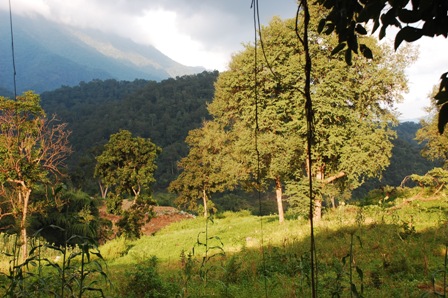An architecture marvel created by world’s best architect. How else we describe this amazing, stupendous, phenomenal creation of nature!
Considered as one of India’s longest caves, Borra Caves is also the deepest, extending up to 80 m. Lit with a few halogen lamps just enough to create visibility for the damp pathways, the setting appears to be a scene from an Indiana Jones movie. Or at times we thought we were in an alien land. We are in fact wordless to describe the experience of Borra Caves and no photographs can capture its real magnificence.



Partially decomposed organic matter creates humic acid in the water. When this acidic water reacts with calcium carbonate in limestone, minerals in the stone get dissolved and the stone disintegrates gradually. As small streams from the hillocks rushed to the Gosthani river below, this chemical reaction kept eroding the stones over a long period of time, leading to the formation of Borra Caves. Had it stopped there, the caves would not have become this famous. The reaction is still going on.








Water percolates from the roof of the caves and reacts with calcium bicarbonate and other minerals on the rock forming mound-like structures on the ground called stalagmites and spear-like structures hanging from the roof called stalactites. The shapes of these structures are so varied in sizes and shapes that it inspires the viewer’s imagination. So there are sculptures of mother-child, Shiva-Parvati, monkeys, brain, crocodile, rishi’s beard, cow’s udder and many more. Whether named or not, we were awestruck by these incredible structures. At one end of the caves is a naturally formed joint that links two huge stones from top to bottom. Somewhere deep inside at a point, a plaque informed us that the Kottavasala-Kirandul railway line passes over the caves, exactly at that point. Thickness of the rock at this point is 100 feet.





There is also a naturally formed Shivling inside the caves, which is worshipped by tribals who inhabit the forests around. Anthropologists have discovered stone tools as old as 30,000 to 50,000 years from the caves. Except for the lighting and fencing in some parts, and a couple of long staircases connecting some of the uneven plains, the cave is maintained as it is. Because of the continuing chemical reaction, new shapes keep forming while the old ones change shape.


Borra Caves is 90 km from Vishakhapatnam and near Araku Valley. Connected by road and rail.





It is similar to a cave we saw in Australia… limestones getting new shapes.
Sometimes they don’t allow photography inside, glad it wasn’t the case here.
Very nice pictures. If youwant to really see the longest caves, you need to travel to Bastar in Chattisgarh. The kutumsar and Kailash Caves are really great. Kutumsar is nearly 1400 m in length and about 30 m below the earth. You may Google them out.
Nice blog for world’s best architect.
amazing!! these look so much like the Patal bhuvaneshwar caves we visited in binsar! similar kind of formations… and likening them to shiva parvati, etc…but it was a fantastic experience!